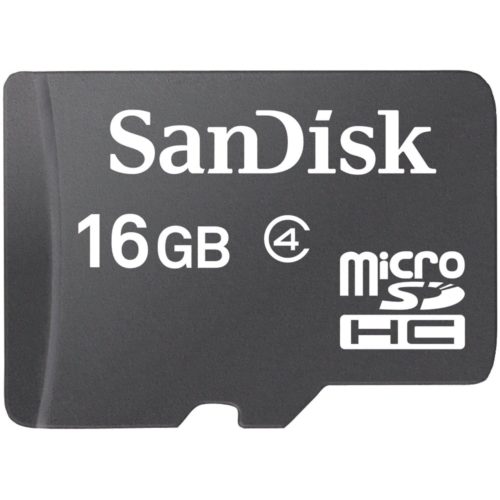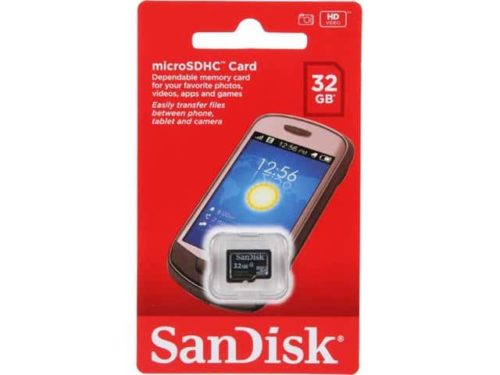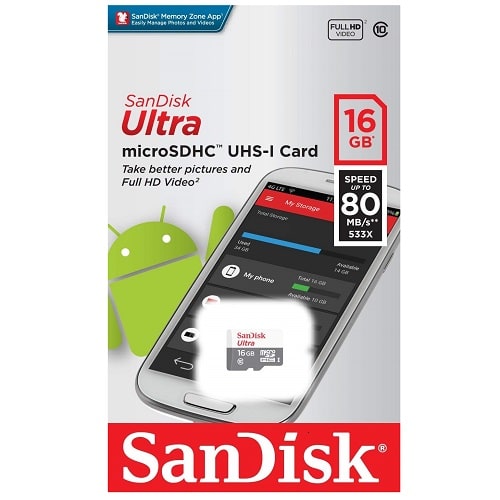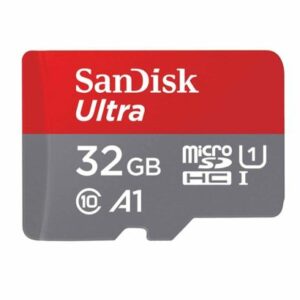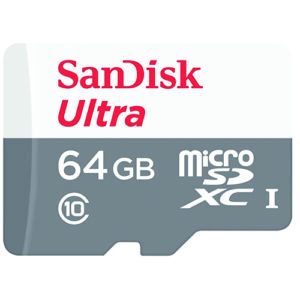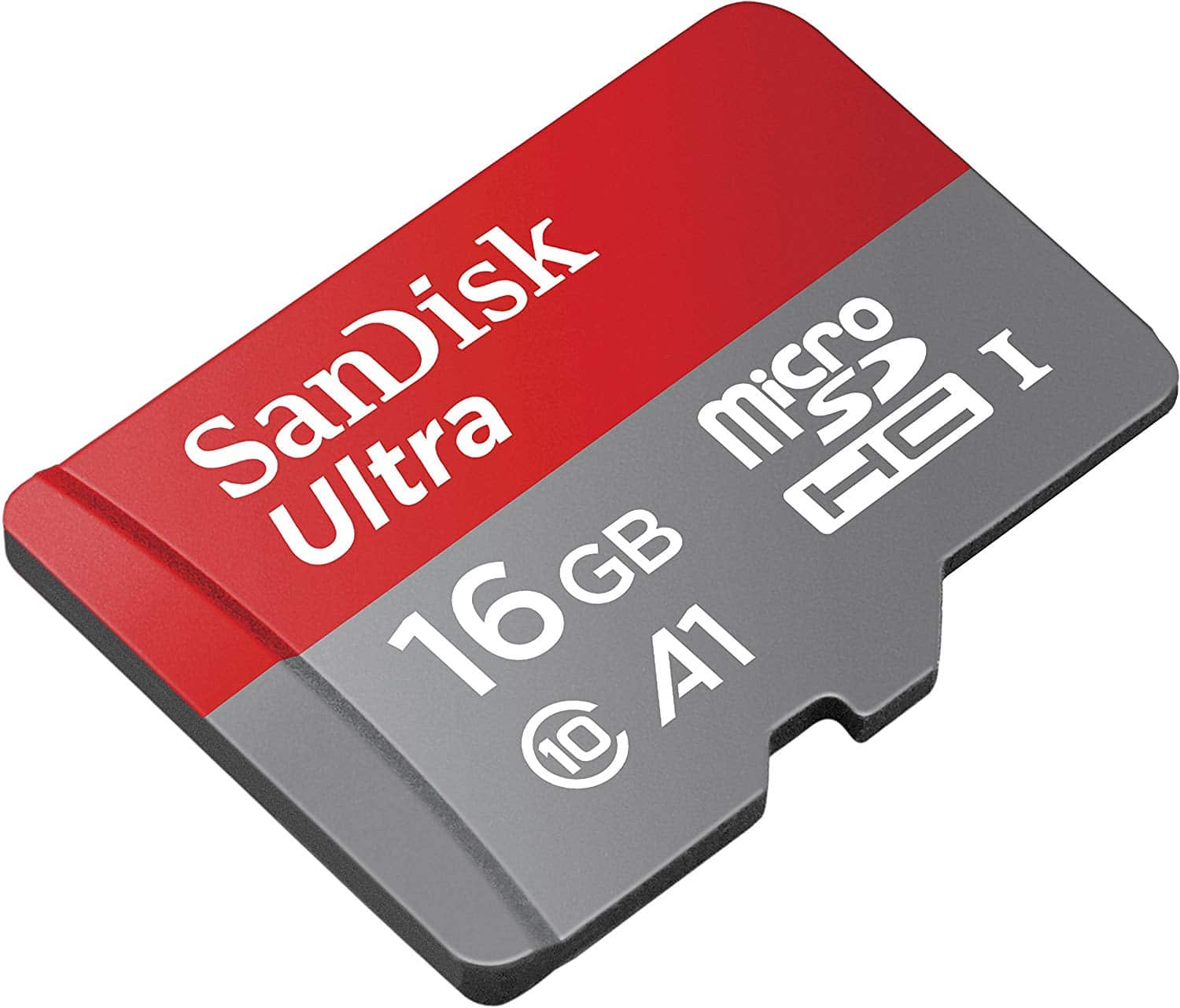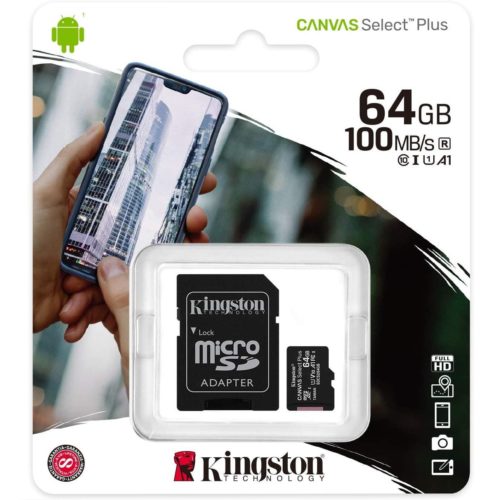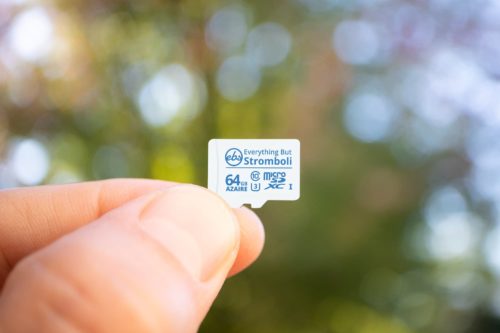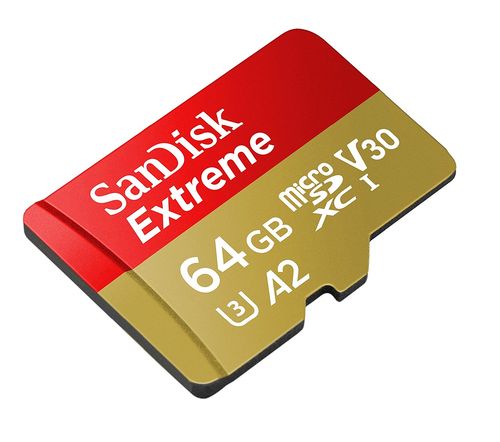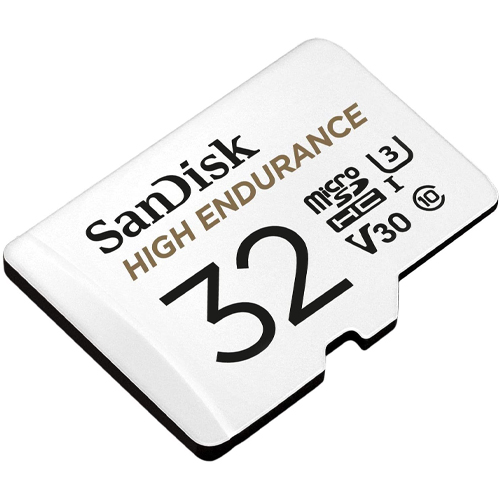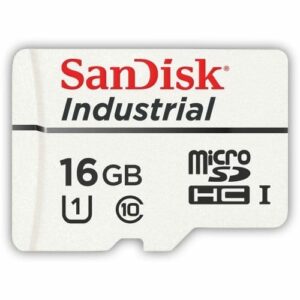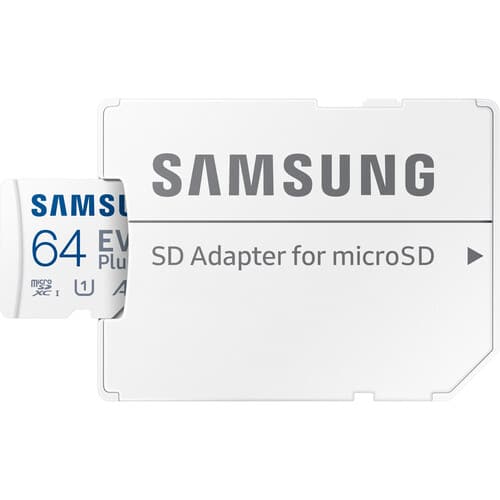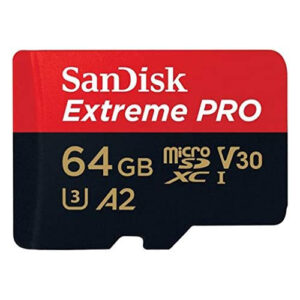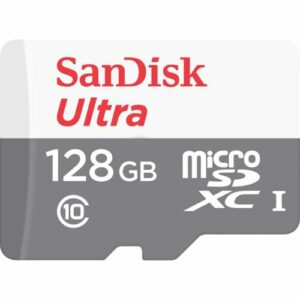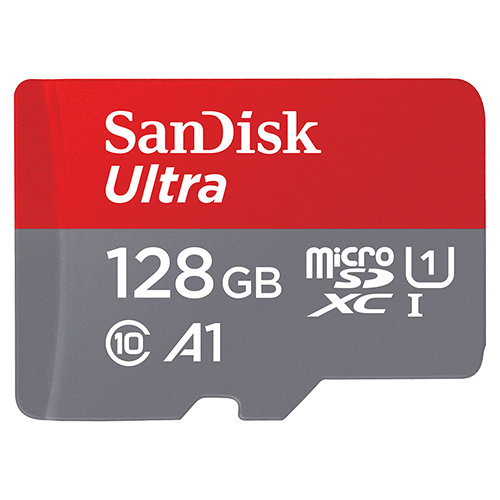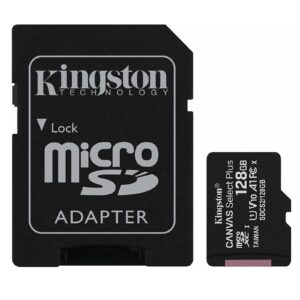MicroSD Cards
Since their introduction in 2006, a MicroSD card, is a tiny, lightweight, removable flash memory card offering high-capacity storage. Measuring 15mm by 11mm by 1mm and weighing only one-quarter gram, these storage solutions are used in computers, cell phones, tablets, and digital action cameras. With storage sizes all the way up to 1.5TB, shop wholesale pricing and bulk discounts right here on our website.
Showing 1–30 of 72 resultsSorted by price: low to high
-

MicroSD 8GB (4)
-

MicroSD 16GB (6)
-

MicroSD 32GB (9)
-

MicroSD 64GB (12)
-

MicroSD 128GB (12)
-

MicroSD 256GB (12)
-

MicroSD 512GB (10)
-

MicroSD 1TB (6)
-

MicroSD 1.5TB (1)
-

All MicroSD Class 4 Cards (3)
-

All MicroSD Class 10 Cards (65)
-
MicroSD Cards
128GB SanDisk High Endurance Video Monitoring Card (SDSQQNR-128G-GN6IA)
High Quality 128GB MicroSD High Endurance SanDisk Card with SD Adapter. This card is great for recording continuous videos, like in dashcams and home video monitoring cameras.
Specifications
- Model Number: SDSQQNR-128G-GN6IA
- Class: 10
- Form Factor: microSDXC
- UHS BUS Speed: UHS-I
- Read Speed: Max 100MB/s
- Write Speed: Max 40MB/s
- UHS Speed Class: U3
- Video Speed Class: V30
- Video Format Capability: Full HD, 4K UHD
- Operating Temperature: -13° – 185° F (-25°C – 85° C)
Estimated Number of Photos & Videos
JPG Photos: 34,490 photos
RAW Photos: 2,380 photos
HD Video: 1,705 minutes
4k Video: 340 minutes**This product comes in original retail packaging ready for resale. EBS return policy linked here.
Model # SDSQQNR-128G-GN6IA
(0 reviews) -
MicroSD Cards
16GB Sandisk Micro SDHC Memory Card (SDSDQM-016G-B35)
High Quality 16GB Micro SDHC Sandisk Card. This card is ideal for picture and video packages. It will hold up to 6,000 photos when using a 10 mega-pixel camera, or 240 minutes of video when recording at 9mbps.
Specifications
- SKU: SDSDQM-016G-B35
- Class: 4
- Form Factor: microSDHC
- UHS BUS Speed: UHS-I
- Read Speed: Max 20MB/s
- Write Speed: Max 5MB/s
- Operating Temperature: -13° – 185° F (-25°C – 85° C)
Estimated Number of Photos & Videos
JPG Photos: 4,310 photos
RAW Photos: 295 photos
HD Video: 210 minutes
4k Video: 40 minutes**This product comes in original retail packaging ready for resale. EBS return policy linked here.
Model # SDSDQM-016G-B35
(6 reviews)From: $4.65
(Pricing as low as $3.80) Select options This product has multiple variants. The options may be chosen on the product page -
MicroSD Cards
32GB Sandisk Micro SDHC Memory Card (SDSDQM-032G-B35)
High Quality 32GB Micro SDHC SanDisk Card. This card is ideal for picture and video packages will hold up to 10,000 photos when using a 10-megapixel camera, or 450 minutes of video when recording at 9mbps.
Specifications
- SKU: SDSDQM-032G-B35
- Class: 4
- Form Factor: microSDHC
- UHS BUS Speed: UHS-I
- Read Speed: Max 20MB/s
- Write Speed: Max 5MB/s
- Operating Temperature: -13° – 185° F (-25°C – 85° C)
Estimated Number of Photos & Videos
JPG Photos: 8,620 photos
RAW Photos: 595 photos
HD Video: 425 minutes
4k Video: 85 minutes**This product comes in original retail packaging ready for resale. EBS return policy linked here.
Model # SDSDQM-032G-B35
(2 reviews)From: $4.65
(Pricing as low as $3.65) Select options This product has multiple variants. The options may be chosen on the product page -
MicroSD Cards
16GB Microsd Ultra Sandisk Memory Card (SDSQUNS-016G-GN3MN)
16GB SanDisk Ultra MicroSD UNS
The SanDisk Ultra MicroSD is a high quality 16GB MicroSD card that is Class 10 and UHS-1. This card is ideal for picture and video recording and is popular for Android smartphones, tablets and computers and works with GoPro cameras. It also works great with trail cameras and dash cams for video feed storage.
Specifications
- SKU: SDSQUNS-016G-GN3MN
- Class: 10
- Form Factor: microSDHC
- UHS BUS Speed: UHS-I
- Read Speed: Max 80MB/s
- Operating Temperature: -13° – 185° F (-25°C – 85° C)
Water proof, Temperature proof, X-ray proof, Shock proof
Estimated Number of Photos & Videos
JPG Photos: 4,310 photos
RAW Photos: 295 photos
HD Video: 210 minutes
4k Video: 40 minutes**This product comes in original retail packaging ready for resale. EBS return policy linked here.
Model # SDSQUNS-016G-GN3MN
(20 reviews)From: $4.70
(Pricing as low as $3.70) Select options This product has multiple variants. The options may be chosen on the product page -
MicroSD 8GB Class 10 w/SD Adapter
8GB MicroSD Class 10 Everything But Stromboli Memory Card with Adapter (EBS-8TF-U1)
8GB EBS MicroSD U1
8GB MicroSD Class 10 Everything But Stromboli Memory Card with Adapter. This card is ideal for picture and video recording on any family or amateur camera, trailcam or hunting camera, and car dash cams. Customers love the affordability and reliability of EBS brand MicroSD cards. The MicroSD card comes with an SD card slot adapter.
Specifications:
- Class 10, U1 Rated – Minimum 10MB/s | Maximum 104MB/s
- Holds an estimated 2,155 JPG Photos or 148 RAW photos
- Roughly 70 minutes of HD video or 21 minutes of 4k video
These cards come with a 1 year guarantee – we will replace defective cards with a new card up to 1 year after purchase. You can view our policies here.
**This product comes in retail packaging ready for resale!
Model #: EBS-8TF-U1
(0 reviews)From: $4.80
(Pricing as low as $3.95) Select options This product has multiple variants. The options may be chosen on the product page -
MicroSD Cards
32GB Microsd Ultra Sandisk Memory Card (SDSQUNR-032G-GN3MN)
SanDisk Ultra MicroSD 32GB UNR
The SanDisk Ultra MicroSD is a high quality 32GB MicroSD card that is Class 10 and UHS-1. This card is ideal for picture and video recording and is popular for Android smartphones, tablets and computers and works with GoPro cameras. It also works great with trail cameras and dash cams for video feed storage.
Specifications
- SKU: SDSQUNR-032G-GN3MN
- Class: 10
- Form Factor: microSDHC
- UHS BUS Speed: UHS-I
- Read Speed: Max 100MB/s
- Operating Temperature: -13° – 185° F (-25°C – 85° C)
Water proof, Temperature proof, X-ray proof, Shock proof
Estimated Number of Photos & Videos
JPG Photos: 8,620 photos
RAW Photos: 595 photos
HD Video: 425 minutes
4k Video: 85 minutes**This product comes in original retail packaging ready for resale. EBS return policy linked here.
Model # SDSQUNR-032G-GN3MN
(15 reviews)From: $4.90
(Pricing as low as $3.90) Select options This product has multiple variants. The options may be chosen on the product page -
MicroSD Cards
16GB MicroSD Class 10 Everything But Stromboli Memory Card with Adapter (EBS-16TF-U1)
16GB MicroSD Class 10 Everything But Stromboli Memory Card with Adapter. This card is ideal for picture and video recording, with the quality of Everything But Stromboli! These cards are U1, ideal for Full HD recording. Minimum sustained write speeds of 10mb/s. Read speeds up to 95mb/s and write speeds up to 25mb/s. These cards come with a 1 year guarantee – we will replace defective cards with a new card up to 1 year after purchase.
**This product is currently available in Plastic Cases
Model #: EBS-16TF-U1
(0 reviews)From: $5.00
(Pricing as low as $4.15) Select options This product has multiple variants. The options may be chosen on the product page -
MicroSD Cards
32GB MicroSD Class 10 Everything But Stromboli Memory Card with Adapter (EBS-32TF-U1)
32GB MicroSD Class 10 Everything But Stromboli Trekshot Memory Card with Adapter. This card is ideal for picture and video recording, with the quality of Everything But Stromboli! These U1 cards are great for Full HD recording with minimum sustained write speeds of 20MB/s. Read speeds reach up to 95mb/s and write speeds up to 35mb/s. These cards come with a 1 year guarantee – we will replace defective cards with a new card up to 1 year after purchase.
**This product comes in plastic jewel cases with the adapter.
Model #: EBS-32TF-U1
(0 reviews)From: $5.30
(Pricing as low as $4.45) Select options This product has multiple variants. The options may be chosen on the product page -
MicroSD Cards
8GB Sandisk Microsd Memory Card (SDSDQAB-008G)
High Quality 8GB MicroSD SanDisk Card. This card is ideal for picture and video packages, will hold up to 3,080 photos when using a 10 mega-pixel camera, or 120 minutes of video when recording at 9mbps.
Specifications
- SKU: SDSDQAB-008G
- Class: 4
- Form Factor: microSDHC
- UHS BUS Speed: UHS-I
- Read Speed: Max 20MB/s
- Write Speed: Max 5MB/s
- Operating Temperature: -13° – 185° F (-25°C – 85° C)
**This product comes in original retail packaging ready for resale. EBS return policy linked here.
Model # SDSDQAB-008G
(8 reviews)From: $5.45
(Pricing as low as $4.60) Select options This product has multiple variants. The options may be chosen on the product page -
MicroSD Cards
32GB MicroSDHC Ultra Sandisk Memory Card (SDSQUA4-032G-GN6MN)
SanDisk Ultra 32GB Micro SDHC Class 10 Performance For Full HD Video 1080p Read speeds up to 120MB.
Great for Android phones including the Samsung Galaxy S10, S9, S8, S8 Note, S7, S7 Edge, and many more.
Specifications
- SKU: SDSQUA4-032G-GN6MN
- Class: 10
- Form Factor: microSDHC
- UHS BUS Speed: UHS-I
- Read Speed: Max 120MB/s
- UHS Speed Class: U1
- App Performance Class: A1
- Video Format Capability: Full HD Video
- Operating Temperature: -13° – 185° F (-25°C – 85° C)
Estimated Number of Photos & Videos
JPG Photos: 8,620 photos
RAW Photos: 595 photos
HD Video: 425 minutes
4k Video: 85 minutes**This product comes in original retail packaging ready for resale. EBS return policy linked here.
Model # SDSQUA4-032G-GN6MN
NOTE: Does NOT include SD Adapter For adapter sold separately click here
(1 review)From: $5.55
(Pricing as low as $4.55) Select options This product has multiple variants. The options may be chosen on the product page -
MicroSD Cards
64GB Microsdxc Ultra Sandisk Memory Card (SDSQUNR-064G-GN3MN)
High Quality 64GB MicroSDXC Ultra SanDisk Card. This card is ideal for picture and video recording.
Specifications
- SKU: SDSQUNR-064G-GN3MN
- Class: 10
- Form Factor: microSDXC
- UHS BUS Speed: UHS-I
- Read Speed: Max 100MB/s
- Operating Temperature: -13° – 185° F (-25°C – 85° C)
Water proof, Temperature proof, X-ray proof, Shock proof
Estimated Number of Photos & Videos
JPG Photos: 17,245 photos
RAW Photos: 1,190 photos
HD Video: 850 minutes
4k Video: 170 minutes**This product comes in original retail packaging ready for resale. EBS return policy linked here.
Model # SDSQUNR-064G-GN3MN
(7 reviews)From: $6.05
(Pricing as low as $5.20) Select options This product has multiple variants. The options may be chosen on the product page -
MicroSD Cards
16GB Microsd Ultra Sandisk Memory Card (SDSQUAR-016G-GN6MN)
SanDisk Ultra MicroSD 16GB UAR
The SanDisk Ultra MicroSD is a high quality 16GB MicroSD card that is Class 10, U1, and A1 rated. This card is ideal for picture and video recording and is popular for Android smartphones, tablets and computers and works with GoPro cameras. It also works great with trail cameras and dash cams for video feed storage.
Specifications
- SKU: SDSQUAR-016G-GN6MN
- Class: 10
- Form Factor: microSDHC
- UHS BUS Speed: UHS-I
- Read Speed: Max 90MB/s
- UHS Speed Class: U1
- App Performance Class: A1
- Video Format Capability: Full HD Video
- Operating Temperature: -13° – 185° F (-25°C – 85° C)
Estimated Number of Photos & Videos
JPG Photos: 4,310 photos
RAW Photos: 295 photos
HD Video: 210 minutes
4k Video: 40 minutes**This product comes in original retail packaging ready for resale. EBS return policy linked here.
Model # SDSQUAR-016G-GN6MN
NOTE: Does NOT include SD Adapter. For adapter sold separately click here
(2 reviews)From: $6.20
(Pricing as low as $5.35) Select options This product has multiple variants. The options may be chosen on the product page -
MicroSD Cards
64GB Kingston Canvas Select Plus Class 10 MicroSDXC Memory Card with SD Adapter (SDCS2/64GB)
High Quality 64GB MicroSD Kingston Canvas Select Plus Card Class 10 with SD Adapter. Very affordable option with 100MB/sec. of read speed.
Specifications
- Model Number: SDCS2/64GB
- Class: 10
- Form Factor: microSDXC
- UHS BUS Speed: UHS-I
- Read Speed: Max 100MB/s
- UHS Speed Class: U1
- Video Speed Class: V10
- App Performance Class: A1
- Operating Temperature: -13° – 185° F (-25°C – 85° C)
Water proof, Temperature proof, X-ray proof, Shock proof, Vibration Proof
Estimated Number of Photos & Videos
JPG Photos: 17,245 photos
RAW Photos: 1,190 photos
HD Video: 850 minutes
4k Video: 170 minutes**This product comes in original retail packaging ready for resale. EBS return policy linked here.
Model # SDCS2/64GB
(0 reviews)From: $6.45
(Pricing as low as $5.45) Select options This product has multiple variants. The options may be chosen on the product page -
MicroSD Cards
64GB MicroSDXC Ultra Sandisk Memory Card (SDSQUAB-064G-GN6MN)
The 64GB SanDisk Ultra UAB MicroSD Card comes in several sizes ranging from 64GB to 512GB. The 64GB SanDisk Ultra microSDXC is an extended SD storage size with good transfer speeds for photo and video. This card works great with DSLRs, point-and-shoot cameras, compact cameras, other products, and more. Perfect for family photos and videos. This card is UHS-1 rated with Class 10 specification. Ideal for a wide range of uses in several products. This SanDisk Ultra card is a great memory card for almost anything. Exceptional picture quality and video performance. 64GB SanDisk Ultra UAB.
Specifications
- SKU: SDSQUAB-064G-GN6MN
- Class: 10
- Form Factor: microSDXC
- UHS BUS Speed: UHS-I
- Read Speed: Max 140MB/s
- UHS Speed Class: U1
- App Performance Class: A1
- Video Format Capability: Full HD Video
- Operating Temperature: -13° – 185° F (-25°C – 85° C)
Estimated Number of Photos & Videos
JPG Photos: 17,245 photos
RAW Photos: 1,190 photos
HD Video: 850 minutes
4k Video: 170 minutes**This product comes in original retail packaging ready for resale. EBS return policy linked here.
Model # SDSQUAB-064G-GN6MN
NOTE: Does NOT include SD Adapter For adapter sold separately click here
(0 reviews)From: $6.55
(Pricing as low as $5.70) Select options This product has multiple variants. The options may be chosen on the product page -
MicroSD Cards
8GB SanDisk Class 10 MicroSDHC Industrial Flash Memory Card (SDSDQAF3-008G-I)
These SanDisk Industrial MicroSD cards are designed and tested to provide quality memory storage in the most outrageous circumstances. This durable, endurance 8GB MicroSD SanDisk card is a very affordable option.
Specifications
- SKU: SDSDQAF3-008G-I
- Class: 10
- Form Factor: microSDHC
- UHS BUS Speed: UHS-I
- Read Speed: Max 80MB/s
- Write Speed: Max 50MB/s
- UHS Speed Class: U1
- Operating Temperature: -13° – 185° F (-25°C – 85° C)
Water proof, Magnet proof, Impact Proof, X-ray proof, Shock proof, Vibration Proof
**This product comes on trays
Model # SDSDQAF3-008G-I
(0 reviews)From: $6.65
(Pricing as low as $5.65) Select options This product has multiple variants. The options may be chosen on the product page -
MicroSD Cards
32GB MicroSDHC Extreme Sandisk Memory Card (SDSQXAF-032G-GN6MN)
Capture more fast action and record more Full HD or 4K UHD video with your Android based smartphone, interchangeable-lens camera, drone or GoPro action camera. The SanDisk Extreme microSDHC and microSDXC UHS-I Cards are built tough for extreme durability under challenging environmental conditions. Extreme speeds let you capture every detail of adventure and take the wait out of transferring your videos between devices. SanDisk products are constructed to the highest standards and rigorously tested. You can be confident in the outstanding quality, performance, and reliability of every SanDisk product.Specifications
- Model Number: SDSQXAF-032G-GN6MN
- Class: 10
- Form Factor: microSDHC
- UHS BUS Speed: UHS-I
- Read Speed: Max 100MB/s
- Write Speed: Max 60MB/s
- UHS Speed Class: U3
- Video Speed Class: V30
- App Performance Class: A1
- Video Format Capability: 4K UHD Video
- Operating Temperature: -13° – 185° F (-25°C – 85° C)
Water proof, Temperature proof, X-ray proof, Shock proof
Estimated Number of Photos & Videos
JPG Photos: 8,620 photos
RAW Photos: 595 photos
HD Video: 425 minutes
4k Video: 85 minutes**This product comes in original retail packaging ready for resale. EBS return policy linked here.Model # SDSQXAF-032G-GN6MN(1 review)From: $7.25
(Pricing as low as $6.25) Select options This product has multiple variants. The options may be chosen on the product page -
MicroSD Cards
64GB MicroSD Class 10 Everything But Stromboli Azaire Memory Card with Adapter (EBS-64TF-U3)
64GB MicroSD Class 10 Everything But Stromboli Azaire Memory Card with Adapter. This card is ideal for picture and video recording, with a U3 rating, great for 4K recording! The minimum sequential write speed is 30mb/s. Read speed is up to 95mb/s, and write speed up to 35mb/s These cards come with a 1 year guarantee – we will replace defective cards with a new card up to 1 year after purchase.
**This product comes in original retail packaging ready for resale.
Model #: EBS-64TF-U3
(1 review)From: $7.30
(Pricing as low as $6.30) Select options This product has multiple variants. The options may be chosen on the product page -
MicroSD Cards
64GB Micro SDXC Extreme Sandisk Memory Card (SDSQXAH-064G-GN6MN)
SanDisk Extreme 64GB microSDXC XAH Class 10 U3 A2 V30 UHS-1
This new Extreme microSD Card from SanDisk has a 64GB capacity. Super high quality speeds with a large SDXC capacity. The ideal card for all types of devices that take a microSD card like trail cameras and action cameras. The 64GB microSD Extreme SanDisk card is a great choice for photographers and professionals looking for higher transfer speeds and higher quality images. Perfect for Raspberry Pi models and DJI drones. This card will work with any compatible drone or action camera with a microSD card slot. The A2 application processing is for applications like software and on compatible phones giving you the best IOPS. You can pair this 64GB card with compatible Blu-ray players, home theaters, and more to expand the storage and hold thousands of songs and hundreds of movies. This card is rated for U3 and Class 10 speeds. The Extreme microSD card can be used for expandable storage on laptops or used to put pictures on digital photo frames. This microSDXC card is waterproof, temperature proof, shock proof, and X-ray proof. SanDisk Extreme 64GB XV2.
Specifications
- Model Number: SDSQXAH-064G-GN6MN
- Class: 10
- Form Factor: microSDXC
- UHS BUS Speed: UHS-I
- Read Speed: Max 170MB/s
- Write Speed: Max 80MB/s
- UHS Speed Class: U3
- Video Speed Class: V30
- App Performance Class: A2
- Video Format Capability: 4K UHD Video
- Operating Temperature: -13° – 185° F (-25°C – 85° C)
Water proof, Temperature proof, X-ray proof, Shock proof
Estimated Number of Photos & Videos
JPG Photos: 17,245 photos
RAW Photos: 1,190 photos
HD Video: 850 minutes
4k Video: 170 minutes**This product comes in original retail packaging ready for resale. EBS return policy linked here.
Model # SDSQXAH-064G-GN6MN
(0 reviews)From: $7.85
(Pricing as low as $6.85) Select options This product has multiple variants. The options may be chosen on the product page -
MicroSD Cards
32GB SanDisk High Endurance Video Monitoring Card (SDSQQNR-032G-GN6IA)
High quality 32GB MicroSD High Endurance SanDisk Card with SD Adapter. This card is great dashcams and home video monitoring cameras.
Specifications
- Model Number: SDSQQNR-032G-GN6IA
- Class: 10
- Form Factor: microSDHC
- UHS BUS Speed: UHS-I
- Read Speed: Max 100MB/s
- Write Speed: Max 40MB/s
- UHS Speed Class: U3
- Video Speed Class: V30
- Video Format Capability: Full HD, 4K UHD
- Operating Temperature: -13° – 185° F (-25°C – 85° C)
Estimated Number of Photos & Videos
JPG Photos: 8,620 photos
RAW Photos: 595 photos
HD Video: 425 minutes
4k Video: 85 minutes**This product comes in original retail packaging ready for resale. EBS return policy linked here.
Model # SDSQQNR-032G-GN6IA
(0 reviews)From: $7.90
(Pricing as low as $6.90) Select options This product has multiple variants. The options may be chosen on the product page -
MicroSD Cards
64GB SanDisk High Endurance Video Monitoring Card (SDSQQNR-064G-GN6IA)
High Quality 64GB MicroSD High Endurance SanDisk Card with SD Adapter. This card is great for recording continuous videos, like in dashcams and home video monitoring cameras.
Specifications
- Model Number: SDSQQNR-064G-GN6IA
- Class: 10
- Form Factor: microSDXC
- UHS BUS Speed: UHS-I
- Read Speed: Max 100MB/s
- Write Speed: Max 40MB/s
- UHS Speed Class: U3
- Video Speed Class: V30
- Video Format Capability: Full HD, 4K UHD
- Operating Temperature: -13° – 185° F (-25°C – 85° C)
Estimated Number of Photos & Videos
JPG Photos: 17,245 photos
RAW Photos: 1,190 photos
HD Video: 850 minutes
4k Video: 170 minutes**This product comes in original retail packaging ready for resale. EBS return policy linked here.
Model # SDSQQNR-064G-GN6IA
(0 reviews)From: $8.00
(Pricing as low as $7.05) Select options This product has multiple variants. The options may be chosen on the product page -
MicroSD Cards
16GB SanDisk Class 10 MicroSDHC Industrial Flash Memory Card (SDSDQAF3-016G-I)
Durable 16GB MicroSD SanDisk Card.
Specifications
- SKU: SDSDQAF3-016G-I
- Class: 10
- Form Factor: microSDHC
- UHS BUS Speed: UHS-I
- Read Speed: Max 80MB/s
- Write Speed: Max 50MB/s
- UHS Speed Class: U1
- Operating Temperature: -13° – 185° F (-25°C – 85° C)
Water proof, Magnet proof, Impact Proof, X-ray proof, Shock proof, Vibration Proof
Estimated Number of Photos & Videos
JPG Photos: 4,310 photos
RAW Photos: 295 photos
HD Video: 210 minutes
4k Video: 40 minutes**This product comes on trays
Model # SDSDQAF3-016G-I
(0 reviews)From: $9.00
(Pricing as low as $8.00) Select options This product has multiple variants. The options may be chosen on the product page -
MicroSD Cards
32GB Micro SDHC Extreme Pro Sandisk Memory Card (SDSQXCG-032G-GN6MA)
SanDisk Extreme Pro 32GB Micro SDHC Class 10 Performance For Full HD Video 1080p and 4K recording, V30. Transfer speeds up to 100MB per second.
Great for GoPro Hero 6, Fusion, Hero 5, and other 4K Action Cameras.
Specifications
- Model Number: SDSQXCG-032G-GN6MA
- Class: 10
- Form Factor: microSDHC
- UHS BUS Speed: UHS-I
- Read Speed: Max 100MB/s
- Write Speed: Max 90MB/s
- UHS Speed Class: U3
- Video Speed Class: V30
- App Performance Class: A1
- Video Format Capability: 4K UHD Video, Full HD Video
- Operating Temperature: -13° – 185° F (-25°C – 85° C)
Water proof, Temperature proof, X-ray proof, Shock proof
Estimated Number of Photos & Videos
JPG Photos: 8,620 photos
RAW Photos: 595 photos
HD Video: 425 minutes
4k Video: 85 minutes**This product comes in original retail packaging ready for resale. EBS return policy linked here.
Model # SDSQXCG-032G-GN6MA
(0 reviews)From: $9.25
(Pricing as low as $8.25) Select options This product has multiple variants. The options may be chosen on the product page -
MicroSD Cards
64GB Micro Samsung EVO Plus SDXC Memory Card (MB-MC64SA)
64GB Samsung EVO Plus Micro SD Card, designed to meet all your storage needs with unmatched performance and versatility. This high-speed card comes equipped with a Samsung adapter for compatibility with a wide range of devices, including computers, handheld gaming consoles, tablets, and cameras. Whether you’re transferring files, capturing memories, or gaming on the go, the 64GB Samsung EVO Plus microSD Card adapts effortlessly to your lifestyle. Experience lightning-fast read and write speeds of up to 160 MB/s, making file transfers nearly instantaneous. This means you can capture every moment in real time, from 4K UHD videos to high-resolution photos, without missing a beat. The EVO Plus ensures that your memories are stored securely and transferred quickly, so you can focus on creating more of them.
Available in storage capacities ranging from 64GB to a massive 1TB, the EVO Plus is designed to grow with you. Whether you’re saving family photos, recording epic adventures, or downloading your favorite games, you’ll have all the space you need. With the right amount of storage, this microSD card is perfect for preserving what matters most to you, all in one place. The EVO Plus is equipped with advanced U3, Class 10, A2, V30, and UHS-I interface technology, providing ultra-high speeds and smooth performance.
Extensively compatible with a wide range of devices, from action cams like GoPro and drones from DJI , the EVO Plus is a versatile and dependable choice for all your storage needs. Whether you’re a professional photographer, gamer, or tech enthusiast, this microSD card delivers the speed, capacity, and durability you need.
Specifications
- Model Number: MB-MC64SA
- Class: 10
- Form Factor: microSDXC
- UHS BUS Speed: UHS-I
- Read Speed: Max 160MB/s
- UHS Speed Class: U1
- Video Speed Class: V10
- App Performance Class: A1
- Operating Temperature: -13° – 185° F (-25°C – 85° C)
Water proof, Temperature proof, X-ray proof, Wear out proof, Magnetic proof, Drop proof
Estimated Number of Photos & Videos
JPG Photos: 17,245 photos
RAW Photos: 1,190 photos
HD Video: 850 minutes
4k Video: 170 minutes**This product comes in original retail packaging ready for resale. EBS return policy linked here.
Model # MB-MC64SA(0 reviews)From: $9.65
(Pricing as low as $8.65) Select options This product has multiple variants. The options may be chosen on the product page -
MicroSD Cards
64GB Kingston Canvas Go! Plus Class 10 MicroSDXC Memory Card with SD Adapter (SDCG3/64GB)
High Quality 64GB MicroSD Kingston Canvas Go! Plus Card Class 10 with SD Adapter. This card is ideal for drones, phones, and cameras.
Specifications
- Model Number: SDCG3/64GB
- Class: 10
- Form Factor: microSDXC
- UHS BUS Speed: UHS-I
- Read Speed: Max 170MB/s
- Write Speed: Max 70MB/s
- UHS Speed Class: U3
- Video Speed Class: V30
- App Performance Class: A2
- Operating Temperature: (-40°C – 85° C)
Water proof, Temperature proof, X-ray proof, Shock proof, Vibration Proof
Estimated Number of Photos & Videos
JPG Photos: 17,245 photos
RAW Photos: 1,190 photos
HD Video: 850 minutes
4k Video: 170 minutes**This product comes in original retail packaging ready for resale. EBS return policy linked here.
Model # SDCG3/64GB
(0 reviews)From: $9.85
(Pricing as low as $8.85) Select options This product has multiple variants. The options may be chosen on the product page -
MicroSD Cards
64GB Micro SDXC Extreme Pro A2 Sandisk Memory Card (SDSQXCU-064G-GN6MA)
SanDisk Extreme Pro 64GB microSDXC XCU Class 10 U3 A2 V30 UHS-1
This new Extreme Pro microSD Card from SanDisk has a 64GB capacity. Super high quality speeds with a large SDXC capacity. The ideal card for all types of devices that take a microSD card like trail cameras and action cameras. The 64GB microSD Extreme Pro SanDisk card is a great choice for photographers and professionals looking for higher transfer speeds and higher quality images. Perfect for Raspberry Pi models and DJI drones. This card will with with any compatible drone or action camera with a microSD card slot. The A2 application processing is for applications like software and on compatible phones giving you the best IOPS. You can pair this 64GB card with compatible Blu-ray players, home theaters, and more to expand the storage and hold thousands of songs and hundreds of movies. This card is rated for U3 and Class 10 speeds. The Extreme Pro microSD card can be used for expandable storage on laptops or used to put pictures on digital photo frames. This microSDXC card is waterproof, temperature proof, shock proof, and X-ray proof. SanDisk Extreme Pro 64GB XCU.
Specifications
- Model Number: SDSQXCU-064G-GN6MA
- Class: 10
- Form Factor: microSDXC
- UHS BUS Speed: UHS-I
- Read Speed: Max 200MB/s
- Write Speed: Max 90MB/s
- UHS Speed Class: U3
- Video Speed Class: V30
- App Performance Class: A2
- Video Format Capability: 4K UHD Video, Full HD Video
- Operating Temperature: -13° – 185° F (-25°C – 85° C)
Water proof, Temperature proof, X-ray proof, Shock proof
Estimated Number of Photos & Videos
JPG Photos: 17,245 photos
RAW Photos: 1,190 photos
HD Video: 850 minutes
4k Video: 170 minutes**This product comes in original retail packaging ready for resale. EBS return policy linked here.
Model # SDSQXCU-064G-GN6MA
(0 reviews)From: $10.05
(Pricing as low as $9.05) Select options This product has multiple variants. The options may be chosen on the product page -
MicroSD Cards
128GB Microsdxc Ultra Sandisk Memory Card (SDSQUNR-128G-GN6MN)
High Quality 128GB MicroSDXC Ultra SanDisk Card. This card is ideal for picture and video recording.
Specifications
- SKU: SDSQUNR-128G-GN6MN
- Class: 10
- Form Factor: microSDXC
- UHS BUS Speed: UHS-I
- Read Speed: Max 100MB/s
- Operating Temperature: -13° – 185° F (-25°C – 85° C)
Water proof, Temperature proof, X-ray proof, Shock proof
Estimated Number of Photos & Videos
JPG Photos: 34,490 photos
RAW Photos: 2,380 photos
HD Video: 1,705 minutes
4k Video: 340 minutes**This product comes in original retail packaging ready for resale. EBS return policy linked here.
Model # SDSQUNR-128G-GN6MN
(2 reviews)From: $10.40
(Pricing as low as $9.40) Select options This product has multiple variants. The options may be chosen on the product page -
MicroSD Cards
64GB Micro SanDisk Nintendo Switch SDXC Memory Card (SDSQXAO-064G-GN3ZN)
64GB SanDisk micro ultra memory card. Class 10, 100MB/s Read speed, 60mb/s write speedThis Nintendo Switch Memory card is the ideal solution for storing and downloading games for the Nintendo Switch and Nintendo Switch Lite. Includes a plastic jewel case for easy transferring and protection.Specifications
- Model Number: SDSQXAO-064G-GN3ZN
- Class: 10
- Form Factor: microSDXC
- UHS BUS Speed: UHS-I
- Read Speed: Max 100MB/s
- Write Speed: Max 60MB/s
- Operating Temperature: -13° – 185° F (-25°C – 85° C)
Designed, Tested and Approved for Nintendo Switch Gaming System
Estimated Number of Photos & Videos
JPG Photos: 17,245 photos
RAW Photos: 1,190 photos
HD Video: 850 minutes
4k Video: 170 minutes**This product comes in original retail packaging ready for resale. EBS return policy linked here.Model # SDSQXAO-064G-GN3ZN(0 reviews)From: $10.45
(Pricing as low as $9.60) Select options This product has multiple variants. The options may be chosen on the product page -
MicroSD Cards
128GB MicroSDXC Ultra Sandisk Memory Card (SDSQUAB-128G-GN6MN)
The 128GB SanDisk Ultra UAC MicroSD Card comes in several sizes ranging from 64GB to 512GB. The 128GB SanDisk Ultra microSDXC is an extended SD storage size with good transfer speeds for photo and video. This card works great with DSLRs, point-and-shoot cameras, compact cameras, other products, and more. Perfect for family photos and videos. This card is UHS-1 rated with Class 10 specification. Ideal for a wide range of uses in several products. This SanDisk Ultra card is a great memory card for almost anything. Exceptional picture quality and video performance. 128GB SanDisk Ultra UAB.
Specifications
- SKU: SDSQUAB-128G-GN6MN
- Class: 10
- Form Factor: microSDXC
- UHS BUS Speed: UHS-I
- Read Speed: Max 140MB/s
- UHS Speed Class: U1
- App Performance Class: A1
- Video Format Capability: Full HD Video
- Operating Temperature: -13° – 185° F (-25°C – 85° C)
Estimated Number of Photos & Videos
JPG Photos: 34,490 photos
RAW Photos: 2,380 photos
HD Video: 1,705 minutes
4k Video: 340 minutes**This product comes in original retail packaging ready for resale. EBS return policy linked here.
Model # SDSQUAB-128G-GN6MN
NOTE: Does NOT include SD Adapter For adapter sold separately click here
(0 reviews)From: $10.50
(Pricing as low as $9.50) Select options This product has multiple variants. The options may be chosen on the product page -
MicroSD Cards
128GB Kingston Canvas Select Plus Class 10 MicroSDXC Memory Card with SD Adapter (SDCS2/128GB)
High Quality 128GB MicroSD Kingston Canvas Select Plus Card Class 10 with SD Adapter. Very affordable option with 100MB/sec. of read speed.
Specifications
- Model Number: SDCS2/128GB
- Class: 10
- Form Factor: microSDXC
- UHS BUS Speed: UHS-I
- Read Speed: Max 100MB/s
- UHS Speed Class: U1
- Video Speed Class: V10
- App Performance Class: A1
- Operating Temperature: -13° – 185° F (-25°C – 85° C)
Water proof, Temperature proof, X-ray proof, Shock proof, Vibration Proof
Estimated Number of Photos & Videos
JPG Photos: 34,490 photos
RAW Photos: 2,380 photos
HD Video: 1,705 minutes
4k Video: 340 minutes**This product comes in original retail packaging ready for resale. EBS return policy linked here.
Model # SDCS2/128GB
(0 reviews)From: $10.70
(Pricing as low as $9.70) Select options This product has multiple variants. The options may be chosen on the product page -
MicroSD Cards
8GB Kingston Industrial Temp Class 10 MicroSDHC Flash Memory Card SDCIT2/8GB
This incredible Kingston Industrial 8GB MicroSD card was designed to be durable. Waterproof, temperature-proof, shockproof, and x-ray proof just to name a few, this microSD card boasts an operating temperature rating of -40 Degree Celsius to 85 Degree Celsius, perfect for harsh environments. The physical build is also strong, it’s rated for 10,000 minimum insertions. Full size SD adapter included. The card has industrial grade features like IPX7 certified water and dust resistant and military standards for its physical durability. Kingston Industrial 8GB MicroSD
Specifications
- Model Number: SDCIT2/8GB
- Class: 10
- Form Factor: microSDHC
- UHS BUS Speed: UHS-I
- Read Speed: Max 100MB/s
- UHS Speed Class: U3
- Video Speed Class: V30
- App Performance Class: A1
- Operating Temperature: -40°C – 85° C
Water proof, Temperature proof, X-ray proof, Shock proof, Vibration Proof
**This product comes in original retail packaging ready for resale. EBS return policy linked here.
Model # SDCIT2/8GB
(0 reviews)From: $11.00
(Pricing as low as $10.15) Select options This product has multiple variants. The options may be chosen on the product page
Top 5 Factors to Consider When Shopping for Bulk Micro SD Cards
When purchasing micro SD cards, take time to explore options and find the right ones for your needs.
First, identify the purpose of these micro cards. This helps determine the required class, size, and read-write speeds. Note that not all MicroSD and SD cards include adapters and plastic jewel cases. Add wallets and memory card readers to your order just in case.
Micro SD cards are versatile and used in many electronic devices. They are compatible with mobile phones, cameras like GoPros, audio recorders, laptops, and DSLR cameras using adapters and card readers. While you can use MicroSD cards in devices that use standard SD cards, avoid relying on adapters permanently.
When to use a MicroSD Card?
MicroSD cards work in some netbooks, Chromebooks, small digital video camcorders, small digital cameras, digital picture frames, game consoles, and MP3 players. Since 2006, MicroSD cards have been used as a discrete or simple way to add or expand storage to your device. Many manufacturers such as GoPro and Raspberry Pi have opted to move away from full size SD cards to MicroSD cards for their size advantage on small form factor devices. Although some people view the MicroSD card as the evolution of the SD card, they exist simultaneously.
MicroSD vs Standard SD
MicroSD cards are about one-quarter the size of standard SD cards. They’re designed for mobile devices and compact electronics, while full-size SD cards are suited for professional digital cameras, handheld camcorders, and laptops. As previously mentioned, MicroSD cards have a size advantage compared to full size SD cards on devices where space is limited. However, MicroSD cards have less heat dissipation surface area and can overheat more. MicroSD card manufacturers make sure to test their MicroSD cards in many conditions and often claim they are temperature proof, x-ray proof, and waterproof. The other major difference between Standard SD and MicroSD is the write-lock switch on the SD card. A MicroSD card does not have a write lock switch.
Top 3 Micro SD Card Brands
Everything But Stromboli offers top MicroSD card brands like Kingston, SanDisk, and Samsung. We sell these brands at wholesale prices with no minimum order quantity and with bulk discount options. Along with our own label, the Azaire microSD card from Everything But Stromboli, SanDisk, Kingston, and Samsung brand microSD cards all share the same quality customer service from our sales team and website. We sell genuine SanDisk, Samsung, and Kingston microSD cards that all come with the manufacturer warranty. MicroSD card brands like SanDisk, Kingston, and Samsung all offer warranty replacement programs for manufacturer defects.
Popular Applications of Micro SD Memory Cards
Many customers use MicroSD cards for storing photos and videos. Because of their high storage capacity, MicroSD cards are a great option for HD video recording and large photo files. Their size makes them perfect for most action cameras, drones, and more. GoPro action cameras, DJI Osmo action cameras, and other devices like drones will use a MicroSD card as the photo and video storage device. We sell many microSD cards for GoPro’s as well as microSD cards for drones.
MicroSD cards can come preloaded with software or applications. Again, due to their size, electronic manufacturing services will use a MicroSD card for storage on their proprietary device. Customers can preload their MicroSD cards with software for running all kinds of applications like video games, manufacturing schematics, and bat files. The rating marker on a MicroSD card for application performance is labeled with an A1 or A2.
Many surveillance cameras also take a MicroSD card. The best micro sd cards for surveillance cameras are high-capacity cards like 128GB and are also rated for a lot of read and write processes. In other words, a durable card with lots of storage. We recommend the best micro sd card for surveillance cameras here.
Other devices like phones and tablets take a micro SD card. Some of the most popular handheld and tablet devices that take a microsd card are the Amazon Fire Tablet, the Samsung Galaxy tablet, and some older android phones. We sell a number of great microsd cards for Amazon Fire tablets, like the 128GB SanDisk Ultra. The Samsung Galaxy tablet Micro SD card options include the 128GB Samsung Pro Plus and 256GB SanDisk Extreme.
Common MicroSD Card Sizes
Consider drive capacity and internal storage when choosing MicroSD cards. Everything But Stromboli stocks a range of sizes from 8 GB to 1.5 TB. Popular sizes include 16 GB, 32 GB, and 64 GB, with 128 GB and 256 GB growing in popularity. SanDisk Extreme and Extreme Pro cards are popular for their improved read and write speeds. Samsung Pro Plus models are the newest in our lineup and are A2 rated MicroSD cards ranging from 128GB to 512GB. Although a 16GB and 32GB microSD card may be the most popular, the larger gigabyte models are growing in popularity with file sizes increasing. With video and photo especially, a 128GB or 256GB card offers action cameras and drones a larger amount of space to record more video and take more photos with higher megapixel cameras. For game consoles like the Steam Deck, we recommend a 512GB or 1TB model to maximize the amount of available space you have for large game files.
MicroSD Card Specs: Understanding Terminology
MicroSD card specs are similar to SD card specs. The main difference is that the adapter must be of the sufficient class if used. MicroSD cards have an additional class represented by an “A.”
- MicroSD Card: Micro Secure Digital Card used in various devices.
- MicroSDHC: Micro Secure Digital High Capacity (4 GB to 32 GB).
- MicroSDXC: Micro Secure Digital eXtended Capacity, optimized for full HD recording.
- Class: Rated classification for write speed (Class 2, 4, 6, 10).
- UHS: Ultra High Speed (U1 writes at 10 MB/s, U3 writes at 30 MB/s).
- V: Video-oriented cards (V6, V10, V30, V60, V90).
- A1: Minimum read speed of 1500 IOPS, write speed of 500 IOPS, 10 MB/s.
- A2: Minimum read speed of 4000 IOPS, write speed of 2000 IOPS, 10 MB/s.
What makes EBS the best place for Bulk Micro SD Cards?
Companies should consider buying MicroSD cards in bulk from BulkMemoryCards.com to maximize savings and ensure a steady supply of cost effective storage solutions. Buying in bulk reduces per-unit costs for our customers, such as tech firms, security companies, and retailers. Starting with wholesale pricing and no minimum order quantity, our bulk discounts and fast shipping make working with us an ideal choice for businesses that prioritize efficiency and cost-effectiveness. Our MicroSD cards are sourced from top brands, ensuring durability and performance. With BulkMemoryCards.com, companies can streamline their procurement process and avoid supply chain disruptions. For organizations looking to secure large quantities of MicroSD cards at unbeatable prices, BulkMemoryCards.com is the best source for bulk MicroSD card purchases.






